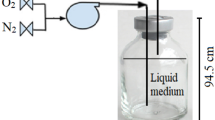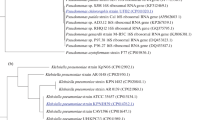Abstract
Thauera sp. strain DKT isolated from sediment utilized 2,4-dichlorophenoxyacetic acid (2,4D) and its relative compounds as sole carbon and energy sources under anaerobic conditions and used nitrate as an electron acceptor. The determination of 2,4D utilization at different concentrations showed that the utilization curve fitted well with the Edward model with the maximum degradation rate as 0.017 ± 0.002 mM/day. The supplementation of cosubstrates (glucose, acetate, sucrose, humate and succinate) increased the degradation rates of all tested chemical substrates in both liquid and sediment slurry media. Thauera sp. strain DKT transformed 2,4D to 2,4-dichlorophenol (2,4DCP) through reductive side-chain removal then dechlorinated 2,4DCP to 2-chlorophenol (2CP), 4-chlorophenol (4CP) and phenol before complete degradation. The relative degradation rates by the isolate in liquid media were: phenol > 2,4DCP > 2CP > 4CP > 2,4D ≈ 3CP. DKT augmentation in sediment slurry enhanced the degradation rates of 2,4D and chlorophenols. The anaerobic degradation rates in the slurry were significantly slower compared to the rates in liquid media.




Similar content being viewed by others
References
APHA (1998) Standard methods for the examination of water and wastewater, 20th edn. American Public Health Association, Washington, DC
Berestovskaya YY, Ignatov VV, Markina LN, Kamenev AA, Makarov OE (2000) Degradation of ortho-chlorophenol, parachlorophenol, and 2,4-dichlorophenoxyacetic acid by the bacterial community of anaerobic sludge. Microbiology 69(4):397–400
Bortolozzi AA, Evangelista De Duffard AM, Duffard RO, Antonelli MC (2004) Effects of 2,4-dichlorophenoxyacetic acid exposure on dopamine D2-like receptors in rat brain. Neurotoxicol Teratol 26(4):599–605
Bouchard R, Beaudet R, Villemur R, McSween G, Lepine F, Bisaillon J-G (1996) Isolation and characterization of Desulfitobacterium frappieri sp. nov. an anaerobic bacterium which reductively dechlorinates PCP to 3-CP. Int J Syst Evol Microbiol 46(4):1010–1015
Boyd SA, Shelton DR, Berry D, Tiedje JM (1983) Anaerobic biodegradation of phenolic compounds in digested sludge. Appl Environ Microbiol 46(1):50–54
Boyle AW, Knight VK, Häggblom MM, Young LY (1999) Transformation of 2,4-dichlorophenoxyacetic acid in four different marine and estuarine sediments: effects of sulfate, hydrogen and acetate on dehalogenation and side-chain cleavage. FEMS Microbiol Ecol 29(1):105–113
Breitenstein A, Saano A, Salkinoja-Salonen M, Andreesen JR, Lechner U (2001) Analysis of a 2,4,6-trichlorophenol-dehalogenating enrichment culture and isolation of the dehalogenating member Desulfitobacterium frappieri strain TCP-A. Arch Microbiol 175(2):133–142
Bryant FO (1992) Biodegradation of 2,4-dichlorophenoxyacetic acid and 2,4,5-trichlorophenoxyacetic acid by dichlorophenoladapted microorganisms from freshwater, anaerobic sediments. Appl Microbiol Biotechnol 38(2):276–281
Celis E, Elefsiniotis P, Singhal N (2008) Biodegradation of agricultural herbicides in sequencing batch reactors under aerobic or anaerobic conditions. Water Res 42(12):3218–3224
Chang BV, Liu JY, Yuan SY (1998) Dechlorination of 2,4-dichlorophenoxyacetic acid and 2,4,5-trichlorophenoxyacetic acid in soil. Sci Total Environ 215(2–1):1–8
Chang Y-C, Reddy MV, Umemoto H, Sato Y, Kang M-H, Yajima Y, Kikuchi S (2016) Bio-augmentation of Cupriavidus sp. CY-1 into 2,4-D contaminated soil: microbial community analysis by culture dependent and independent techniques. PLoS ONE 10:e0145057
Charles JM, Hanley TR, Wilson RD, van Ravenzwaay B, Bus JS (2001) Development toxicity studies in rats an rabbits on 2,4-dichlorophenoxyacetic acid an its forms. Toxicol Sci 60(1):121–131
Chinalia FA, Killham KS (2006) 2,4-Dichlorophenoxyacetic acid (2,4-D) biodegradation in river sediments of Northeast Scotland and its effect on the microbial communities (PLFA and DGGE). Chemosphere 64(10):1675–1683
Cho YS, Kahng HY, Kim CK, Kukor JJ, Oh KH (2002) Physiological and cellular responses of the 2,4-D degrading bacterium, Burkholderia cepacia YK-2, to the phenoxyherbicides 2,4-D and 2,4,5-T. Curr Microbiol 45(6):415–422
Collins G, Foy C, McHugh S, O’Flaherty V (2005) Anaerobic treatment of 2,4,6-trichlorophenol in an expanded granular sludge bed-anaerobic filter (EGSB-AF) bioreactor at 15C. FEMS Microbiol Ecol 53(1):167–178
Cox C (1999) 2,4-D: ecological effects. Herbcide factsheet. J Pestic Reform 19:14–19
Czaplicka M (2004) Sources and transformations of chlorophenols in the natural environment. Sci Total Environ 322(1–3):21–39
Dai Y, Li N, Zhao Q, Xie S (2015) Bioremediation using Novosphingobium strain DY4 for 2,4-dichlorophenoxyacetic acid-contaminated soil and impact on microbial community structure. Biodegradation 26(2):161–170
Duc HD (2016) Biodegradation of 3-chloroaniline by suspended cells and biofilm of Acinetobacter baumannii GFJ1. Appl Biol Chem 59:703–709
Duc HD (2017) Degradation of chlorotoluenes by Comamonas testosterone KT5. Appl Biol Chem 60(4):457–465
Duffard R, Garcia G, Rosso S, Bortolozzi A, Madariaga M, di Paolo O, Evangelista de Duffard AM (1996) Central nervous system myelin deficit in rats exposed to 2,4-dichlorophenoxyacetic acid throughout lactation. Neurotoxicol Teratol 18(6):691–696
Edwards VH (1970) The influence of high substrate concentrations on microbial kinetics. Biotechnol Bioeng 12:679–712
Frank R, Logan L (1988) Pesticide and industrial chemical residues at the mouth of the grand, Saugeen and Thames rivers, Ontario, Canada, 1981–1985. Arch Environ Contam Toxicol 17(6):741–754
Gerritse J, Renard V, Pedro Gomes TM, Lawson PA, Collins MD, Gottschal JC (1996) Desulfitobacterium sp. strain PCE1, an anaerobic bacterium that can grow by reductive dechlorination of tetrachloroethene or ortho-chlorinated phenols. Arch Microbiol 165(2):132–140
Gibson SA, Suflita JM (1990) Anaerobic biodegradation of 2,4,5-trichlorophenoxyacetic acid in samples from a methanogenic aquifer: simulation by short-chain organic acids and alcohols. Appl Environ Microbiol 56(6):1825–1832
González AJ, Gallego A, Gemini VL, Papalia M, Radice M, Gutkind G, Planes E, Korol SE (2012) Degradation and detoxification of the herbicide 2,4-dichlorophenoxyacetic acid (2,4-D) by an indigenous Delftia sp. strain in batch and continuous systems. Int Biodeterior Biodegrad 66(1):8–13
Greer LE, Shelton DR (1992) Effect of inoculant strain and organic matter content on kinetics of 2,4-dichlorophenoxyacetic acid degradation in soil. Appl Environ Microbiol 58(5):1459–1465
Greer CW, Hawari J, Samson R (1990) Influence of environmental factors on 2,4-dichlorophenoxyacetic acid degradation by Pseudomonas cepacia isolated from peat. Arch Microbiol 154(4):317–322
Häggblom MM, Young LY (1990) Chlorophenol degradation coupled to sulfate reduction. Appl Environ Microbiol 56(11):3255–3260
Häggblom MM, Rivera MD, Young LY (1993) Influence of alternative electron acceptors on the anaerobic biodegradability of chlorinated phenols and benzoic acids. Appl Environ Microbiol 59(4):1162–1167
Hope BK, Pillsbury L, Boling B (2012) A state-wide survey in Oregon (USA) of trace metals and organic chemicals in municipal effluent. Sci Total Environ 417–418:263–272
Hossain HMZ, Kawahata H, Roser BP, Sampei Y, Manaka T, Otani S (2017) Geochemical characteristics of modern river sediments in Myanmar and Thailand: implications for provenance and weathering. Chem Erde-Geochem 77:443–458
Kim CS, Keizer RF, Pritchard JB (1988) 2,4-Dichlorophenoxyacetic acid intoxication increases its accumulation within the brain. Brain Res 440(2):216–226
Kim HJ, Park YI, Dong MS (2005) Effects of 2,4-D and DCP on the DHT-induced androgenic action in human prostate cancer cells. Toxicol Sci 88(1):52–59
Klecka G, Persoon C, Currie R (2010) Chemicals of emerging concern in the Great Lakes Basin: an analysis of environmental exposures. Rev Environ Contam Toxicol 207:1–93
Kolpin D, Barbash J, Gilliom R (2000) Pesticides in Ground Water of the United States, 1992–1996 38:858–863
Konasewich D, Traversy W, Zar H (1978) Great Lakes Water Quality Status Report on Organic and Heavy Metal Contaminants in the Lakes Erie, Michigan, Huron and Superior Basins to the Implementation Committee of the Great Lakes Water Quality Board. International Joint Commission (IJC) Digital Archive
Kwangjick L, Johnson VJ, Barry R, Blakley BR (2001) The effect of exposure to a commercial 2,4-D formulation during gestation on the immune response in CD-1 mice. Toxicology 165(1):39–49
Liu S-M, Kuo C-E, Hsu T-B (1996) Reductive dechlorination of chlorophenols and PCP in anoxic estuarine sediments. Chemosphere 32(7):1287–1300
Masunaga S, Susarla S, Gundersen JL, Yonezawa Y (1996) Pathways and rate of chlorophenol transformation in anaerobic estuarine sediment. Environ Sci Technol 30(4):1253–1260
Mattsson J, Charles J, Yano B, Cunny L, Wilson R, Bus J (1997) Single-dose and chronic dietary neurotoxicity screening studies on 2,4-dichlorophenoxyacetic acid in rats. Fundam Appl Toxicol 40(1):11–119
Michalowicz J, Duda W (2007) Phenols-sources and toxicity. Pol J Environ Stud 16:347–362
Mikesell MD, Boyd SA (1985) Reductive dechlorination of the pesticides 2,4-D, 2,4,5-T and PCP in anaerobic sludges. J Environ Qual 14:337–340
Mohn WW, Kennedy KJ (1992) Limited degradation of chlorophenols by anaerobic sludge granules. Appl Environ Microbiol 58(7):2131–2136
Moody RP, Wester RC, Melendres JL, Maibach HI (1992) Dermal absorption of the phenoxy herbicide 2,4-D dimethylamine in humans: effect of DEET and anatomic site. J Toxicol Environ Health 36(3):241–250
Reddy GVB, Joshi DK, Gold MH (1997) Degradation of chlorophenoxyacetic acids by the lignin-degrading fungus Dichornitus squalens. Microbiology 143:2353–2360
Robles-González I, Ríos-Leal E, Ferrera-Cerrato R, Esparza-García F, Rinderkenecht-Seijas N, Poggi-Varaldo HM (2006) Bioremediation of a mineral soil with high contents of clay and organic matter contaminated with herbicide 2,4-dichlorophenoxyacetic acid using slurry bioreactors: effect of electron acceptor and supplementation with an organic carbon source. Process Biochem 41(9):1951–1960
Song B, Palleroni NJ, Kerkhof LJ, Haggblom MM (2001) Characterization of halobenzoate-degrading, denitrifying Azoarcus and Thauera isolates and description of Thauera chlorobenzoica sp. nov. Int J Syst Evol Microbiol 51:589–602
Suflita JM, Stout J, Tiedje JM (1984) Dechlorination of (2,4,5-trichlorophenoxy)acetic acid by anaerobic microorganisms. J Agric Food Chem 32(2):218–221
Wang Y-T, Muthukrishnan S, Wang Z (1998) Reductive dechlorination of chlorophenols in methanogenic cultures. J Environ Eng 124(3):231–238
Wang YB, Wu CY, Wang XJ, Zhou SG (2009) The role of humic substances in the anaerobic reductive dechlorination of 2,4-dichlorophenoxyacetic acid by Comamonas koreensis strain CY01. J Hazard Mater 164(2–3):941–947
Webber MD, Wang C (1995) Industrial organic compounds in selected Canadian soils. Can J Soil Sci 75(4):513–524
WHO (1989) Chlorophenols other than pentachlorophenol, Environmental Health Criteria 93. World Health Organization, Geneva
Willemsen RE, Hailey A (2001) Effects of spraying the herbicides 2,4-D and 2,4,5-T on a population of the tortoise Testudo hermanni in southern Greece. Environ Pollut 113(1):71–78
Williams WM, Holden PW, Parsons DW, Lorber MN (1988) Pesticides in groundwater data base 1988 Interim report, Office Pesticide Programs. U.S. Environmental Protection Agency, Washington, D. C., p 37
Wu C-Y, Zhuang L, Zhou S-G, Li F-B, Li X-M (2010) Fe(III)-enhanced anaerobic transformation of 2,4-dichlorophenoxyacetic acid by an iron-reducing bacterium Comamonas koreensis CY01. FEMS Microbiol Ecol 71(1):106–113
Wu CY, Zhuang L, Zhou SG, Yuan Y, Yuan T, Li FB (2013) Humic substance-mediated reduction of iron(III) oxides and degradation of 2,4-D by an alkaliphilic bacterium, Corynebacterium humireducens MFC-5. Microb Biotechnol 6(2):141–149
Xia ZY, Zhang L, Zhao Y, Yan X, Li SP, Gu T, Jiang JD (2017) Biodegradation of the herbicide 2,4-dichlorophenoxyacetic acid by a new isolated strain of Achromobacter sp. LZ35. Curr Microbiol 74(2):193–202
Yang Z, Xu X, Dai M, Wang L, Shi X, Guo R (2017) Rapid degradation of 2,4-dichlorophenoxyacetic acid facilitated by acetate under methanogenic condition. Bioresour Technol 232:146–151
Zeyer J, Wasserfallen A, Timmis KN (1985) Microbial mineralization of ring-substituted anilines through an ortho-cleavage pathway. Appl Environ Microbiol 50(2):447–453
Zhang X, Wiegel J (1990) Sequential anaerobic degradation of 2,4-dichlorophenol in freshwater sediments. Appl Environ Microbiol 56(4):1119–1127
Acknowledgements
This study was carried out at the same time and same place as the determination of anaerobic degradation of chloroanilines. We are very thankful to our families, especially my wife Nguyen Thi Oanh (Dong Thap University, Viet Nam) for all the support provided to do this study.
Author information
Authors and Affiliations
Corresponding author
Rights and permissions
About this article
Cite this article
Ha, D.D. Anaerobic degradation of 2,4-dichlorophenoxyacetic acid by Thauera sp. DKT. Biodegradation 29, 499–510 (2018). https://doi.org/10.1007/s10532-018-9848-7
Received:
Accepted:
Published:
Issue Date:
DOI: https://doi.org/10.1007/s10532-018-9848-7




